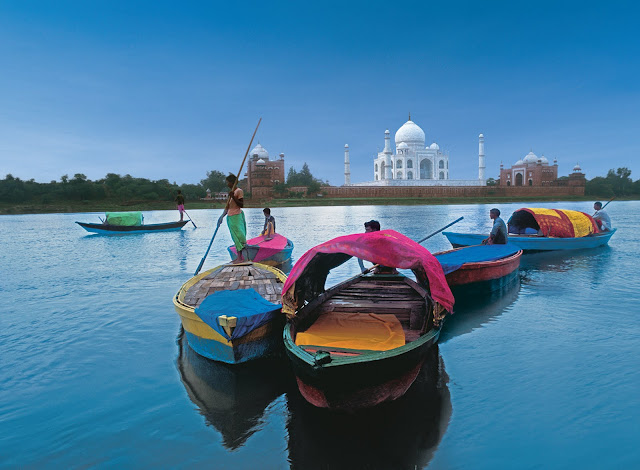“The sight of this mansion creates sorrowing sighs;Shah Jahan, the Mughal Emperor on Taj Mahal
And the sun and the moon shed tears from their eyes.
In this world this edifice has been made;
To display thereby the creator's glory”
 |
| Taj Mahal, a UNESCO World Heritage Site is also voted one of the Modern Wonders of the World |
Taj Mahal, a UNESCO World Heritage Site, is acknowledged for its immaculate symmetry. Taj Mahal was built on a marble platform that stands upon a sandstone platform in turn. Taj Mahal is known for its carvings, fine inlay work incorporating semi-precious stone, calligraphy and lapidary work which appear almost alive especially the work done inside the structure.
- Taj Mahal is inscribed as a World Heritage Site by UNESCO
- Taj Mahal was built as a mausoleum of Mumtaj Mahal, wife of Mughal Emperor Shah Jahan. Mausoleum is a building that contains burial chambers (tombs) for the deceased
- Both Mumtaj Mahal and Shah Jahan are buries inside Taj Mahal
- Taj Mahal translates to Crown of the Palaces
- It took 20 years to build Taj Mahal
- Construction of Taj Mahal started in 1632 and it was finished around 1653
- The construction of Taj Mahal involved 22,000 laboureres and architects
- More than a thousand elebhants carried the construction material required for building Taj Mahal
- 50 wells were dug and filled with material as base to construct Taj Mahal to keep it from harm ways from water of river Yamuna
- Taj Mahal is custructed entirely of white marble
- The full height of the Taj Mahal is 171 metres (561 feet)
- Taj Mahal takes on different coloring at different times of the day, from a pinkish hue in the morning, milky white in the evening and golden at night when lit by the moon
- The complex is set around a large 300-metre (980 ft) square charbagh or Mughal garden
- Charbagh symbolizes the four flowing rivers of Jannat (an Urdu word meaning Paradise) and reflects the Paradise garden
- The Architect of Taj Mahal was Ustad Ahmad Lahauri
- Nearly 4 million tourist visit Taj Mahal every year
- Verses from Quran have been inscribed as decorative elements throughout the complex
- The calligraphy on Taj Mahal was created by a calligrapher named Abd ul-Haq
- Inlay work in the interiors of Taj Mahal is lapidary of precious and semiprecious gemstones
- Many precious stones and Lapis Lazuli (a semi-precious stone) were chiseled out from its walls by the British during the Indian rebellion of 1857
Entry Fee:
Citizens of India and visitors of SAARC (Bangladesh, Nepal, Bhutan, Sri Lanka, Pakistan, Maldives and Afghanistan) and BIMSTEC Countries (Bangladesh, Nepal, Bhutan, Sri Lanka, Thailand and Myanmar) - Rs. 20 per head.
Fee for Foreign Travelers:
Rs. 250/- per head (ASI);
Rs. 500/- per head as Toll Tax (Agra Development Authority)
Rs. 500/- ticket of ADA is valid for the monuments of Agra Fort, Itimadi-ud-daula, Akbar’s Tomb, Sikandara and Fatehpur Sikri (Children up to 15 years free)
For more information about Taj Mahal Tours.












